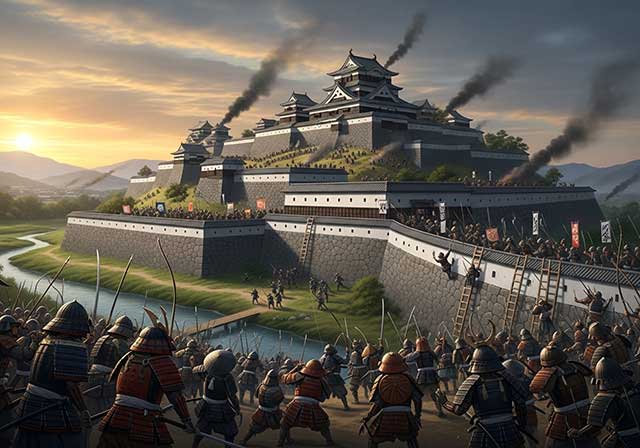
In 1537, the head of the Ogigayatsu branch of the Uesugi clan, Uesugi Tomooki, died. He was succeeded by his son, the thirteen-year-old Uesugi Tomosada (1525–1546). Hojo Ujitsuna (1487–1541), who had long been planning to expand his holdings in Musashi Province, decided to take advantage of the new daimyo's inexperience. He assembled an army of 7,000 soldiers and marched on Kawagoe Castle.
Tomosada was unable to hold Kawagoe, even though his father had bequeathed him to defend the castle at the cost of his own life. The young daimyo was forced to retreat and take refuge in Matsuyama Castle, which at that time was owned by one of Uesugi's chief vassals, Nambata Norishige. Here, Tomosada hoped to regroup his forces and continue the fight against Ujitsuna.
Matsuyama Castle was a typical mountain castle of the early Sengoku Jidai period. It was located on a 40-meter plateau stretching from west to east. On one side of the plateau flowed the Namegawa River, which served as a natural defensive boundary, and on the other side, at the foot of the hill, a wide moat had been dug. The fortification system included four courtyards located one after another: the main courtyard, hommaru; the second courtyard, ninomaru; the Kasugamaru courtyard; and the third courtyard, sannomaru. The castle's defenses also included dry moats, karabori; artificial slopes, kirigishi; and vertical trenches, tatebori.
Hojo's troops, pursuing the retreating Tomosada, attempted to take Matsuyama on the march. However, the combined forces of Uesugi and Nambata launched a bold counterattack and managed to win.
The siege of Matsuyama Castle also went down in history as the “elegant battle.” According to legend, during the battle, a poetic duel took place between Nambata Norishige and Yamanaka Shuzan, one of the commanders of the Hojo clan's army.
Another legend related to this event has also survived. The Uesugi clan allegedly sent a request for reinforcements to their allied clan in a very unusual way: they put a letter in the collar of the castle dog. However, there is no reliable information about how effective this method was.
After repelling the attack, Matsuyama Castle became the main base of the Ogigayatsu Uesugi clan for the next eight years, until their defeat in the unsuccessful siege of Kawagoe Castle in 1545.
See also
-
The Siege of Hara Castle

The Shimabara Rebellion of 1637–1638, which culminated in the siege of Hara Castle, was the last major uprising of the Edo period and had serious political consequences.
-
Battle of Tennoji

The confrontation between Tokugawa Ieyasu and Toyotomi Hideyori during the “Osaka Winter Campaign” ended with the signing of a peace treaty. On January 22, 1615, the day after the treaty was signed, Ieyasu pretended to disband his army. In reality, this meant that the Shimazu forces withdrew to the nearest port. On the same day, almost the entire Tokugawa army began filling in the outer moat.
-
Siege of Shuri Castle

The Ryukyu Kingdom was established in 1429 on Okinawa, the largest island of the Ryukyu (Nansei) archipelago, as a result of the military unification of three rival kingdoms. In the following years, the state's control spread to all the islands of the archipelago.
-
The Siege of Fushimi Castle

Fushimi can perhaps be considered one of the most “unfortunate” castles of the Sengoku Jidai period. The original castle was built by Toyotomi Hideyoshi in the southeast of Kyoto in 1594 as his residence in the imperial city.
-
The Siege of Otsu Castle

The siege of Otsu Castle was part of the Sekigahara campaign, during which the so-called Eastern Coalition, led by Tokugawa Ieyasu, fought against the Western Coalition, led by Ishida Mitsunari. Otsu Castle was built in 1586 by order of Toyotomi Hideyoshi near the capital Kyoto, on the site of the dismantled Sakamoto Castle. It belonged to the type of “water castles” — mizujō — as one side of it faced Japan's largest lake, Lake Biwa, and it was surrounded by a system of moats filled with lake water, which made the fortress resemble an island.
-
The Siege of Shiroishi Castle

The siege of Shiroishi Castle was part of the Sekigahara campaign and took place several months before the decisive battle of Sekigahara. The daimyo of Aizu Province, Uesugi Kagekatsu, posed a serious threat to Tokugawa Ieyasu's plans to defeat the Western Coalition, and Ieyasu decided to curb his actions with the help of his northern vassals. To this end, he ordered Date Masamune to invade the province of Aizu and capture Shiroishi Castle.
-
The Second Siege of Jinju Castle

During the two Korean campaigns of the 16th century, the Japanese repeatedly had to capture enemy fortresses and defend occupied or constructed fortifications from the combined Korean and Chinese forces. Among all the operations of that time, the second siege of Jinju Castle is considered the most interesting from the point of view of siege warfare.
-
The Siege of Takamatsu Castle

The siege of Takamatsu Castle in Bitchu Province is considered the first mizuzeme, or “water siege,” in Japanese history. Until then, such an original tactic had never been used.

